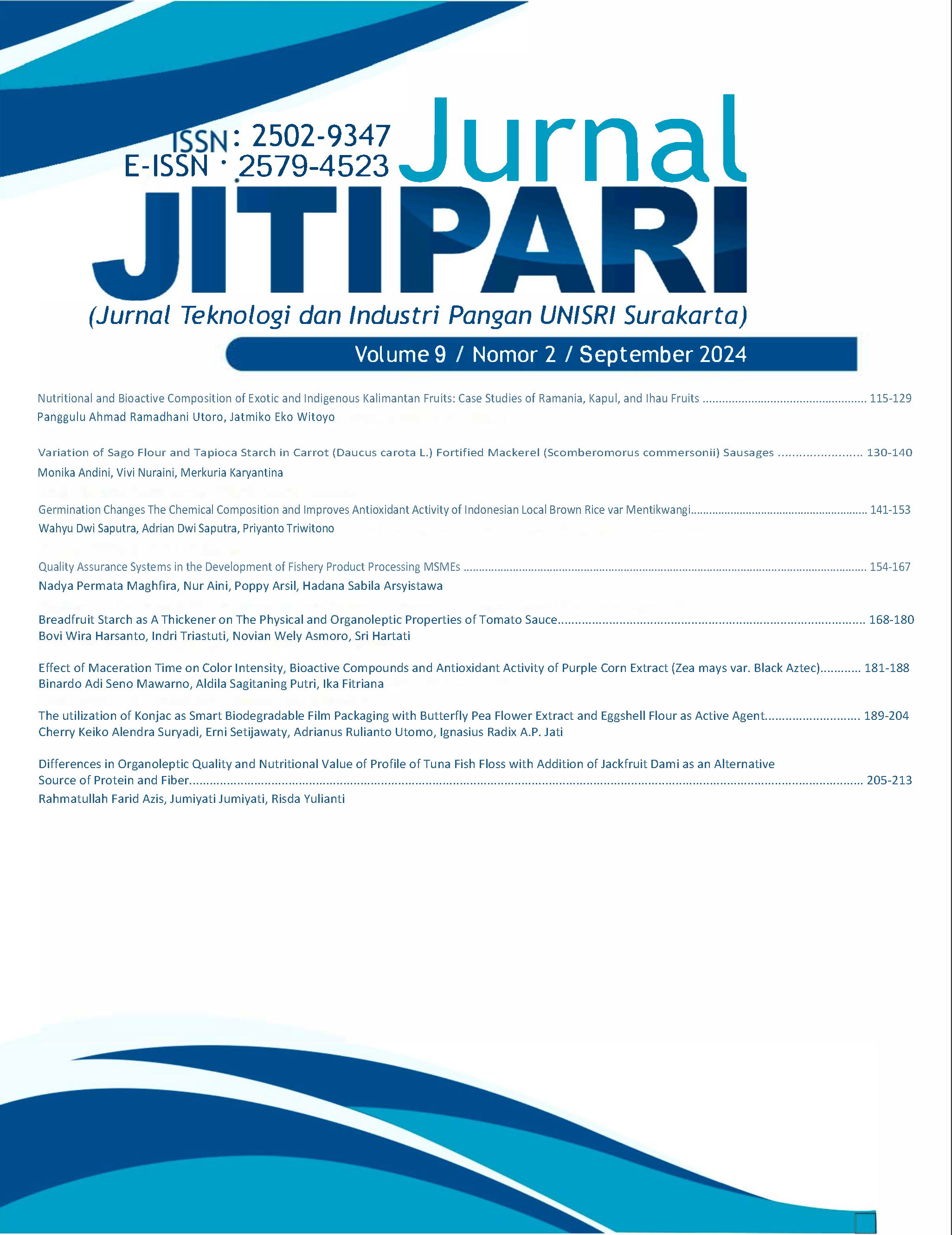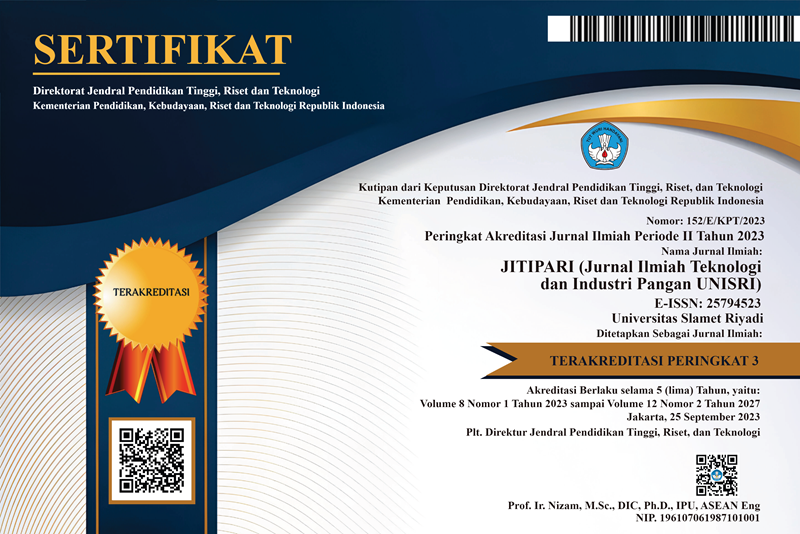Breadfruit Starch as A Thickener on The Physical and Organoleptic Properties of Tomato Sauce
Peran Pati Sukun Sebagai Pengental Terhadap Sifat Fisik Dan Organoleptik Saus Tomat
DOI:
https://doi.org/10.33061/jitipari.v9i2.10914Abstract
Indonesian people widely consume tomato sauce as a condiment or food seasoning. The natural thickening agent commonly used in tomato sauce is starch, generally based on tapioca or cornstarch. The use of breadfruit starch as a thickener is rarely studied and needs to be researched scientifically. This research aimed to evaluate the role of breadfruit starch as a thickener in tomato sauce. This research began with extracting breadfruit starch through wet milling and continued with making tomato sauce based on breadfruit starch. The concentration of breadfruit starch was varied in 3 levels, namely 0.5%, 1%, and 1.5%. Commercial tomato sauce was also evaluated and used as a comparison. Viscosity, color, and organoleptic analyses were conducted on tomato sauce products. The results showed that tomato sauce based on 1.5% breadfruit starch had a higher viscosity (3220.5 cP) than the addition of 0.5% (572 cP) and 1% (1093.5 cP) starch, but it was still much lower than the viscosity of commercial tomato sauce (6922.5 cP). In terms of color, breadfruit starch-based tomato sauce is not much different from commercial tomato sauce in terms of brightness (L: 32-35), redness (a: 9-11), and yellowness (b: 10-15). After organoleptic analysis, the panelists rated the breadfruit starch-based tomato sauce as mediocre (average score 3), compared to the commercial tomato sauce, which the panelists preferred (score 4). These findings indicate that breadfruit starch has potential as a thickener for tomato sauce because it can resemble the quality of tomato sauce in terms of color. However, the concentration of added breadfruit starch still needs to be increased to increase the thickness of the tomato sauce and its acceptance by consumers.
References
Adato, A., Mandel, T., Mintz-Oron, S., Venger, I., Levy, D., Yativ, M., DomÃnguez, E., Wang, Z., De Vos, R. C. H., Jetter, R., Schreiber, L., Heredia, A., Rogachev, I., & Aharoni, A. (2009). Fruit-surface flavonoid accumulation in tomato is controlled by a SLMYB12-regulated transcriptional network. PLoS Genetics, 5(12), e1000777. https://doi.org/10.1371/journal.pgen.1000777
Adebowale, K. O., Olu-Owolabi, B. I., Olawumi, E. K., & Lawal, O. S. (2005). Functional properties of native, physically and chemically modified breadfruit (Artocarpus artilis) starch. Industrial Crops and Products, 21(3), 343–351. https://doi.org/10.1016/j.indcrop.2004.05.002
Ahouagi, V. B., Mequelino, D. B., Tavano, O. L., Garcia, J. A. D., Nachtigall, A. M., & Vilas Boas, B. M. (2021). Physicochemical characteristics, antioxidant activity, and acceptability of strawberry-enriched ketchup sauces. Food Chemistry, 340, 127925. https://doi.org/10.1016/j.foodchem.2020.127925
Anandsynal, Mumtaz, B., Motalab, M., Jahan, S., Hoque, M. M., & Saha, *. (2018). Nutritional and microbiological evaluation on sauces and ketchups available in Bangladesh. International Food Research Journal, 25(1), 357–365.
Anggreini, R. A., Choiriyah, N. A., & Athennia, A. (2021). Modification of sorghum bicolor (L) moench starch: review of HMT (heat moisture treatment), autoclaving cooling, and annealing methods. International Journal of Advance Tropical Food (IJATF), 3(2), 57–66. https://doi.org/10.26877/ijatf.v3i2.9927
Anwar, S. H., Rahmah, M., Safriani, N., Hasni, D., Rohaya, S., & Winarti, C. (2016). Exploration of breadfruit, jicama, and rice starches as stabilizer in food emulsion. International Journal on Advanced Science Engineering Information Technology, 6(2).
Arifin, M., Ningsih, R., Helmi, A. S., Oktrison, & Elfina, S. (2023). Inovasi produk saus tomat menggunakan tepung labu kuning sebagai pengental. Jurnal Pengabdian Cendikia Nusantara, 1(2), 50–55.
Auriema, B. E., Correa, F. J., Silva, R., Soares, P. T. S., Lima, A. L., Vidal, V. A. S., Raices, R. S. L., Pollonio, M. A. R., Luchese, R. H., Esmerino, E. A., & Mathias, S. P. (2022). Fat replacement by green banana biomass: Impact on the technological, nutritional and dynamic sensory profiling of chicken mortadella. Food Research International, 152. https://doi.org/10.1016/j.foodres.2021.110890
Ballester, A. R., Molthoff, J., de Vos, R., Hekkert, B. te L., Orzaez, D., Fernández-Moreno, J. P., Tripodi, P., Grandillo, S., Martin, C., Heldens, J., Ykema, M., Granell, A., & Bovy, A. (2010). Biochemical and molecular analysis of pink tomatoes: Deregulated expression of the gene encoding transcription factor SLMYB12 leads to pink tomato fruit color. Plant Physiology, 152(1), 71–84. https://doi.org/10.1104/pp.109.147322
Cai, X., Du, X., Zhu, G., Cai, Z., & Cao, C. (2020). The use of potato starch/xanthan gum combinations as a thickening agent in the formulation of tomato ketchup. CYTA - Journal of Food, 18(1), 401–408. https://doi.org/10.1080/19476337.2020.1760943
D’Ambrosio, C., Stigliani, A. L., & Giorio, G. (2018). CRISPR/Cas9 editing of carotenoid genes in tomato. Transgenic Research, 27(4), 367–378. https://doi.org/10.1007/s11248-018-0079-9
Dhakal, R., & Baek, K. H. (2014). Metabolic alternation in the accumulation of free amino acids and γ-aminobutyric acid in postharvest mature green tomatoes following irradiation with blue light. Horticulture Environment and Biotechnology, 55(1), 36–41. https://doi.org/10.1007/s13580-014-0125-3
Diantom, A., Curti, E., Carini, E., & Vittadini, E. (2017). Effect of added ingredients on water status and physico-chemical properties of tomato sauce. Food Chemistry, 236, 101–108. https://doi.org/10.1016/j.foodchem.2017.01.160
Feitosa, B. F., Alcântara, C. M. de, Lucena, Y. J. A. de, Oliveira, E. N. A. de, Cavalcanti, M. T., Mariutti, L. R. B., & Lopes, M. F. (2023). Green banana biomass (Musa spp.) as a natural food additive in artisanal tomato sauce. Food Research International, 170. https://doi.org/10.1016/j.foodres.2023.113021
Hailu, G. G., & Admassu, H. (2024). Potential stabilization effect of native and modified anchote (Coccinia abyssinica) starches in tomato sauce. International Journal of Food Properties, 27(1), 12–33. https://doi.org/10.1080/10942912.2023.2293658
Harni, M., Anggraini, T., Rini, & Suliansyah, I. (2022). Review artikel: pati pada berbagai sumber tanaman. Agroteknika, 5(1), 26–39. https://doi.org/10.55043/agroteknika.v5i1.118
Harsanto, B. W., Pranoto, Y., Supriyanto, & Kartini, I. (2021). Breadfruit-Based Starch Nanoparticles Prepared Using Nanoprecipitation to Stabilize a Pickering Emulsion. Journal of Southwest Jiaotong University, 56(3), 372–383. https://doi.org/10.35741/issn.0258-2724.56.3.31
Hasan, S. M. K., Kabir, M. R., Kabir, M. R., Islam, M. R., Akhter, M. J., & Moury, J. Y. (2022). Proximate composition, minerals, phytochemicals, and functional activities of jujube fruits grown in Bangladesh. Journal of Agriculture and Food Research, 8. https://doi.org/10.1016/j.jafr.2022.100302
Heriyanto, S., & Romulo, A. (2023). Tomato pomace ketchup: physicochemical, microbiological, and sensory characteristics. Food Processing: Techniques and Technology, 53(4), 766–774. https://doi.org/10.21603/2074-9414-2023-4-2477
Hoover, R. (2001). Composition, molecular structure, and physicochemical properties of tuber and root starches: a review. Carbohydrate Polymers, 45, 253–267. www.elsevier.com/locate/carbpol
Islam, M. R., Biswas, M. M. H., Esham, M. K. H., Roy, P., khan, M. R., & Hasan, S. M. K. (2023). Jackfruit (Artocarpus heterophyllus) by-products a novel source of pectin: Studies on physicochemical characterization and its application in soup formulation as a thickener. Food Chemistry Advances, 2. https://doi.org/10.1016/j.focha.2023.100273
Islam, M. R., Haque, A. R., Kabir, M. R., Hasan, M. M., Khushe, K. J., & Hasan, S. M. K. (2021). Fruit by-products: the potential natural sources of antioxidants and α-glucosidase inhibitors. Journal of Food Science and Technology, 58(5), 1715–1726. https://doi.org/10.1007/s13197-020-04681-2
Kabir, M. R., Hasan, S. M. K., Islam, M. R., & Ahmed, M. (2024). Development of functional noodles by encapsulating mango peel powder as a source of bioactive compounds. Heliyon, 10(1). https://doi.org/10.1016/j.heliyon.2024.e24061
Kaur, M., & Singh, S. (2019). Influence of heat-moisture treatment (HMT) on physicochemical and functional properties of starches from different Indian oat (Avena sativa L.) cultivars. International Journal of Biological Macromolecules, 122, 312–319. https://doi.org/10.1016/j.ijbiomac.2018.10.197
Kelebek, H., Kesen, S., Sonmezdag, A. S., Cetiner, B., Kola, O., & Selli, S. (2018). Characterization of the key aroma compounds in tomato pastes as affected by hot and cold break process. Journal of Food Measurement and Characterization, 12(4), 2461–2474. https://doi.org/10.1007/s11694-018-9863-8
Koh, S. P., & Long, K. (2012). Comparison of physical, chemical and functional properties of broken rice and breadfruit starches against cassava starch. J. Trop. Agric. and Fd. Sc, 40(2), 211–219.
Latifah, H., & Yunianta. (2017). Modifikasi pati garut (Marantha arundinacea) metode ganda (ikatan silang - substitusi) dan aplikasinya sebagai pengental pada pembuatan saus cabai. Jurnal Pangan Dan Agroindustri, 5(4), 31–41.
Li, X., Zeng, X., Song, H., Xi, Y., Li, Y., Hui, B., Li, H., & Li, J. (2023). Characterization of the aroma profiles of cold and hot break tomato pastes by GC-O-MS, GC × GC-O-TOF-MS, and GC-IMS. Food Chemistry, 405. https://doi.org/10.1016/j.foodchem.2022.134823
Li, Y., Nie, J., Shi, L., Xie, Y., Tan, D., Yang, X., Zhang, C., & Zheng, J. (2022). Transcriptomic and metabolomic profiling reveals the mechanisms of color and taste development in cherry tomato cultivars. LWT, 167. https://doi.org/10.1016/j.lwt.2022.113810
Mohamed, A., Xu, J., & Singh, M. (2010). Yeast leavened banana-bread: Formulation, processing, colour and texture analysis. Food Chemistry, 118(3), 620–626. https://doi.org/10.1016/j.foodchem.2009.05.044
Nwokocha, L. M., & Williams, P. A. (2011). Comparative study of physicochemical properties of breadfruit (Artocarpus altilis) and white yam starches. Carbohydrate Polymers, 85(2), 294–302. https://doi.org/10.1016/j.carbpol.2011.01.050
Petró-Turza, M. (1986). Flavor of tomato and tomato products. Food Reviews International, 2(3), 309–351. https://doi.org/10.1080/87559128609540802
Rahmah, N., Aulia, A., & Hidayat, R. (2022). Pemanasan dan konsentrasi tepung maizena dalam pembuatan saus tomat. Seminar Nasional Hasil Pertanian, 1713–1726.
Rahman, M. M., Hasan, S. M. K., Sarkar, S., Ashik, M. A. I., Somrat, M. A. M., & Asad, A. I. (2024). Effect of formulation on physiochemical, phytochemical, functional, and sensory properties of the bioactive sauce blended with tomato and pumpkin pulp. Applied Food Research, 4(1). https://doi.org/10.1016/j.afres.2024.100406
Ranieri, L. M., & Delani, T. C. D. O. (2014). Green banana (Musa spp): getting the biomass and physiological actions of resistant starch. Uninga, 20(3), 43–49.
Schafranski, K., Ito, V. C., & Lacerda, L. G. (2021). Impacts and potential applications: A review of the modification of starches by heat-moisture treatment (HMT). Food Hydrocolloids, 117. https://doi.org/10.1016/j.foodhyd.2021.106690
Serrano, E., Beltrán, J., & Hernández, F. (2009). Application of multiple headspace-solid-phase microextraction followed by gas chromatography-mass spectrometry to quantitative analysis of tomato aroma components. Journal of Chromatography A, 1216(1), 127–133. https://doi.org/10.1016/j.chroma.2008.11.026
Sit, N., Misra, S., Baruah, D., Badwaik, L. S., & Deka, S. C. (2014). Physicochemical properties of taro and maize starch and their effect on texture, colour and sensory quality of tomato ketchup. Starch/Staerke, 66(3–4), 294–302. https://doi.org/10.1002/star.201300120
Sjarif, S. R., & Apriani, S. W. (2016). Pengaruh bahan pengental pada saus tomat. Jurnal Penelitian Teknologi Industri, 8(2), 141–150.
Song, Y., Teakle, G., & Lillywhite, R. (2023). Unravelling effects of red/far-red light on nutritional quality and the role and mechanism in regulating lycopene synthesis in postharvest cherry tomatoes. Food Chemistry, 414. https://doi.org/10.1016/j.foodchem.2023.135690
Susanti, S., Bintoro, V. P., Hintono, A., Zuniati, N., & Arifan, F. (2020). Optimasi substitusi saus tomat dengan ekstrak buah semu jambu monyet pada formulasi bumbu marinasi steak. Jurnal Ilmiah Sains, 20(2), 134. https://doi.org/10.35799/jis.20.2.2020.30261
Tan, X., Li, X., Chen, L., Xie, F., Li, L., & Huang, J. (2017). Effect of heat-moisture treatment on multi-scale structures and physicochemical properties of breadfruit starch. Carbohydrate Polymers, 161, 286–294. https://doi.org/10.1016/j.carbpol.2017.01.029
Triastuti, I., Hartati, S., & Asmoro, N. W. (2024). Karakteristik saus tomat dengan berbagai variasi konsentrasi pati sukun (Artocarpus communis) sebagai pengental alami. Journal of Food and Agricultural Product, 4(1), 27–34.
Ulyarti, U., Lavlinesia, L., Nuzula, N., & Nazarudin, N. (2019). Sifat fungsional pati ubi kelapa kuning (Dioscorea alata) dan pemanfaatannya sebagai pengental pada saus tomat. AgriTECH, 38(3), 235. https://doi.org/10.22146/agritech.30965
Yan, X., McClements, D. J., Luo, S., Liu, C., & Ye, J. (2024). Recent advances in the impact of gelatinization degree on starch: Structure, properties and applications. Carbohydrate Polymers, 122273. https://doi.org/10.1016/j.carbpol.2024.122273
Zeng, X., Li, H., Jiang, W., Li, Q., Xi, Y., Wang, X., & Li, J. (2022). Phytochemical compositions, health-promoting properties and food applications of crabapples: A review. In Food Chemistry (Vol. 386). Elsevier Ltd. https://doi.org/10.1016/j.foodchem.2022.132789
Downloads
Published
How to Cite
Issue
Section
License
Copyright (c) 2024 Bovi Wira Harsanto, Indri Triastuti, Novian Wely Asmoro, Sri Hartati

This work is licensed under a Creative Commons Attribution-ShareAlike 4.0 International License.
Authors who publish this journal agree to the following terms:
- Authors retain copyright and grant the journal right of first publication with the work simultaneously licensed under a Creative Commons Attribution-ShareAlike 4.0 International (CC BY-SA 4.0) that allows others to share the work with an acknowledgement of the work's authorship and initial publication in this journal.
- Authors can separately make additional contractual arrangements for non-exclusive distribution published by the journal (e.g., publish it in a book), with an acknowledgement of its initial publication in this journal.
- Authors are allowed and encouraged to send their work via online (e.g., in the institutional repositories or their website) after published by the journal.










